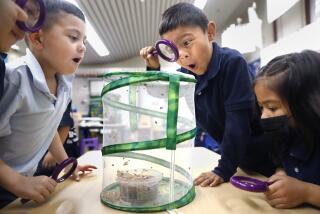COSTA MESA : Classes Help 3rd-Graders Spell ‘Unity’
- Share via
As the final bell rings, dismissing students at Kaiser Elementary, about 35 third-graders stay put.
Instead of heading for home, they meet for an extra class new to the curriculum this year.
Three days a week for 50 minutes, white students learn Spanish as a second language, along with Latino students who were either born in the United States or moved here at a young age and, consequently, missed out on proper instruction in Spanish grammar, vocabulary, reading and writing.
The fledgling class--actually, three classes with about 12 students in each--has already produced interesting results.
“You take a Spanish-speaking third-grader who struggles in (the regular day’s) class, and they suddenly become the smartest student here,” said Kaiser Principal Christine Jurenka, who is bilingual. “They are helping each other in life’s situations and in language as well.”
Jurenka said the class has already lowered the barriers of language and culture that separate the school’s students who come from the largely Latino neighborhoods of Costa Mesa and the white neighborhoods in Newport Beach. “They learn to appreciate another culture, and we have noticed that they have started playing together (at recess) because there is no language barrier,” she said.
And Kaiser parents enthusiastically support the after-school sessions because their children learn a useful skill. Jurenka said that the waiting list of 20 students and the willingness of parents to volunteer proves that the classes are popular, and necessary.
Students “are going to have the world open up to them if they are truly bilingual,” said the principal. “And if learning a language is easier at a younger age, then why not start early?”
Philip Gerard is one of the third-graders who is proud of being able to speak a second language. Philip relishes the chances he gets to use his skills outside the classroom such as when he watches Spanish-language television.
He added that it is also fun to surprise people in his neighborhood by speaking Spanish with them.
“They get real surprised that I know some Spanish. They call their friends over and say, ‘Hey, this guy speaks Spanish. He is pretty good.’ ”
His teacher, Sherilynne Dangl uses songs, flash cards and diagrams to teach basic vocabulary and phrases. The curriculum that was taught during the day in English is repeated in Spanish in the after-school session. Students pick it up faster after hearing it a second time in another language.
Eliel Gama, who was born in Mexico and came to Costa Mesa when he was 4 years old, said that though Spanish is spoken regularly at his home, he knows he can improve his use of it.
In addition, Gama and others regularly cannibalize their spoken Spanish by throwing in English words such as lunch or bicycle . Latino parents have told Dangl that they want their children to speak proper, fluent Spanish as well as English.
“They see the importance of knowing both languages,” Dangl said.
Many of the school’s students began learning Spanish in kindergarten at nearby Kaiser Primary. Jurenka said it is unclear whether the school has enough resources and bilingual teachers to create a fourth-grade Spanish curriculum next year for the 45 third-graders due to leave the program.
“We have got to start thinking about that part right after Christmas,” Jurenka said.
More to Read
Sign up for Essential California
The most important California stories and recommendations in your inbox every morning.
You may occasionally receive promotional content from the Los Angeles Times.










